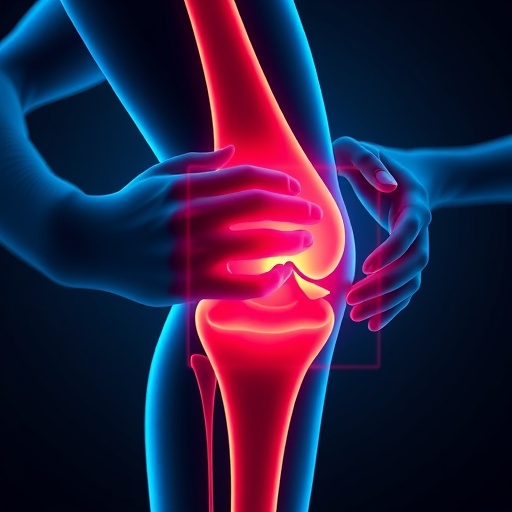The realm of total knee replacement (TKR) surgeries has undergone significant transformation, primarily owing to advancements in digital technology and personalized medicine. As healthcare continues to evolve, the integration of personalized digital decision aids into clinical consultations is emerging as a pivotal enhancement in patient-centered care. A salient study by Deckert et al. meticulously delves into the dynamics surrounding the use of personalized digital decision aids within the domain of TKR consultations, highlighting both facilitators and barriers as experienced by patients and orthopaedic surgeons alike.
At the heart of the study lies a qualitative exploration of patient and surgeon perceptions. The researchers conducted a series of insightful interviews, drawing from rich narratives that illuminate the real-world applications and challenges of integrating digital tools into clinical settings. By focusing on both the patient and the surgeon’s perspectives, the study offered a balanced evaluation of how these digital aids can support informed decision-making processes, thereby enhancing the overall quality of care in TKR consultations.
One of the most compelling findings of the study pertains to the facilitators that enhance the adoption of digital decision aids. These aids are designed to provide patients with tailored information and options that resonate with their unique preferences and medical histories. By empowering patients, these tools can foster a collaborative dialogue between patients and healthcare providers, ultimately leading to more informed decisions regarding surgical interventions. Patients expressed that having access to personalized information alleviates anxiety and enhances their confidence in the decision-making process, thus promoting better outcomes.
However, the study also unearthed significant barriers that impede the widespread utilization of these digital aids. Many patients reported feelings of technological apprehension, particularly among older populations who may be less familiar with digital interfaces. This technophobia can lead to feelings of exclusion or inadequacy when attempting to engage with these digital resources, underscoring the need for clear guidance and support from healthcare practitioners. Additionally, the availability of technology and internet access played a crucial role in determining the feasibility of using these aids, particularly in underserved or rural communities.
Moreover, the interviews revealed variations in perceptions between patients and surgeons regarding the value and efficacy of these digital decision aids. While surgeons often appreciate the potential for these tools to enhance their consultations, some expressed concerns about the reliability of the information delivered through them. Surgeons emphasized the importance of ensuring that the content is accurate, evidence-based, and easy to interpret, highlighting a critical intersection where technology must align with clinical integrity.
The dialogue between patients and surgeons that arises from using digital decision aids also prompts considerations about the evolving roles within the healthcare landscape. As patients increasingly demand roles as active participants in their healthcare decisions, the traditional patient-provider dynamics are shifting. This shift impacts how surgeons approach consultations, necessitating a greater emphasis on communication skills and patient engagement strategies. The study suggests that orthopaedic surgeons should be adept in navigating these new dynamics to foster a collaborative environment conducive to shared decision-making.
In terms of improving the design and implementation of digital decision aids, the findings advocate for user-centered approaches that prioritize patient feedback. By involving patients in the development process, creators can ensure that the tools meet actual needs and preferences, thus enhancing usability and user satisfaction. This paradigm shift towards incorporating user experiences into the design process represents a significant step toward creating effective digital health interventions.
Furthermore, considering the ongoing advancements in telemedicine and digital health technologies, the implications of this study extend beyond the confines of TKR consultations. The lessons learned here can inform the development of digital decision aids across various medical fields, establishing a framework that prioritizes personalization, accuracy, and user engagement. Such efforts can ultimately contribute to a larger movement towards patient empowerment in healthcare decisions.
In summary, this enlightening study sheds light on the intricate relationships between personalized digital decision aids, patient empowerment, and surgical decision-making processes in total knee replacement consultations. By addressing both facilitating and hindering factors, the research presents a nuanced perspective that underscores the critical role of technology in modern healthcare. As orthopedic surgeons and patients continue to explore the integration of digital aids into their consultations, the potential for improved outcomes and enhanced satisfaction is undeniably promising.
The journey toward effective utilization of digital decision aids in TKR consultations is far from over. However, the insights provided by Deckert et al. lay a vital foundation for future research and development in this area. It is this kind of ambulatory innovation that is not only changing the face of orthopedic surgery but also redefining the patient experience in profound ways. The path forward will require collaboration, education, and unwavering commitment to advancing patient-centered care in an increasingly digital world.
By embracing these novel strategies and overcoming the barriers identified, the healthcare community can harness the power of technology to elevate the standards of care in knee replacements and beyond. As the narrative of healthcare continues to unfold, the interplay between digital advancements and patient engagement will be pivotal in shaping the future of medical consultations and decision-making processes.
Subject of Research: The use of personalized digital decision aids in total knee replacement consultations.
Article Title: Facilitators and barriers to the use of a personalised digital decision aid in total knee replacement consultations: insights from patients and orthopaedic surgeons – an interview study.
Article References: Deckert, S., Slesaczeck, J., Druschke, D. et al. Facilitators and barriers to the use of a personalised digital decision aid in total knee replacement consultations: insights from patients and orthopaedic surgeons – an interview study. BMC Health Serv Res 25, 1387 (2025). https://doi.org/10.1186/s12913-025-13351-y
Image Credits: AI Generated
DOI: 10.1186/s12913-025-13351-y
Keywords: Total knee replacement, digital decision aid, patient empowerment, orthopedic surgery, patient-centered care, healthcare technology, qualitative study.




